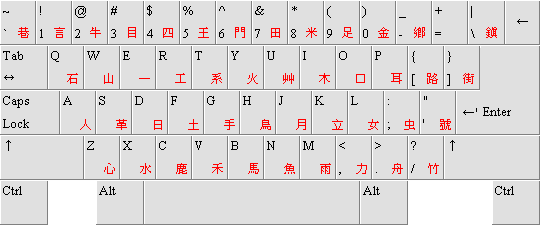Dayi method
Dayi (Chinese: 大易; pinyin: dàyì, literally "big easy") uses a set of 46 character components laid out on a standard QWERTY keyboard. A Chinese character is built by combining up to four of the 40 of the 46 characters (the other six are provided for typing Taiwanese addresses), using a system similar to that of Cangjie, but is decomposed in stroke order instead of in geometric shape in Cangjie.
On most keyboards in Taiwan, most keys show four symbols. On the keys, the Latin letters are in the upper left, Zhuyin symbols on the upper right, Cangjie symbols on the lower left, and Dayi symbols on the lower right.
Unlike other input methods, Dayi's use of 46 character components instead of 26 happens to be its greatest impediment, because it makes typing digits and punctuation marks very inconvenient.

Like Cangjie, every radical has some auxiliary shapes; but some of the auxiliary shapes of one radical originate from the mnemonic word of the radical. For example, key 6 is mapped to 車(car) in the keyboard, its mnemonic word is "6片車門"(six pieces of car door), and its auxiliary shapes include "片"(piece), "爿"(old character for "wall", its shape is the reflection of "片"), "甫"(its shape is like "車"), "門"(door), "鬥"(to battle or to fight, its shape is like "門").